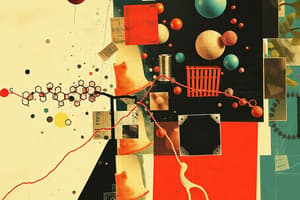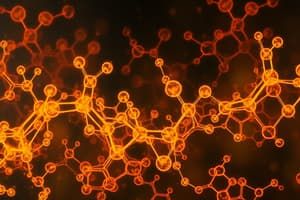Podcast
Questions and Answers
What is the equation for photosynthesis?
What is the equation for photosynthesis?
6CO2 + 6H2O + energy = C6H12O6 + 6O2
What are chemical reactions?
What are chemical reactions?
When molecules are broken down to form other molecules
What is required for a reaction to occur?
What is required for a reaction to occur?
Reactants must collide with enough energy
What is activation energy?
What is activation energy?
What are biochemical reactions?
What are biochemical reactions?
What is the sum of all reactions in a cell?
What is the sum of all reactions in a cell?
For a cell to survive it must have a fast what?
For a cell to survive it must have a fast what?
Enzymes are biological what?
Enzymes are biological what?
How do enzymes increase the rate of reaction?
How do enzymes increase the rate of reaction?
How many times can enzymes be reused?
How many times can enzymes be reused?
What is the reactant that acts with an enzyme?
What is the reactant that acts with an enzyme?
Substrates fit specifically into what on an enzyme?
Substrates fit specifically into what on an enzyme?
Substrate and enzyme are also known as a what model?
Substrate and enzyme are also known as a what model?
What is induced fit?
What is induced fit?
What happens when an induced fit strains the bond of the substrate?
What happens when an induced fit strains the bond of the substrate?
What is the catalytic cycle of an enzyme (4 steps)?
What is the catalytic cycle of an enzyme (4 steps)?
What are the factors that affect the speed of chemical reactions and enzymes?
What are the factors that affect the speed of chemical reactions and enzymes?
How do the amount of substrates and enzymes increase the rate of reaction?
How do the amount of substrates and enzymes increase the rate of reaction?
How does temperature increase the rate of reaction?
How does temperature increase the rate of reaction?
How does pH increase the rate of reaction?
How does pH increase the rate of reaction?
How do competitive inhibitors decrease the rate of reaction?
How do competitive inhibitors decrease the rate of reaction?
How do non-competitive inhibitors decrease the rate of reaction?
How do non-competitive inhibitors decrease the rate of reaction?
Enzymes flat line when all enzymes are what?
Enzymes flat line when all enzymes are what?
What happens to an enzyme after the reaction?
What happens to an enzyme after the reaction?
What is a catalyst?
What is a catalyst?
What is feedback inhibition?
What is feedback inhibition?
Why is inhibition important?
Why is inhibition important?
How do antibiotics work?
How do antibiotics work?
Flashcards are hidden until you start studying
Study Notes
Photosynthesis
- Photosynthesis equation: 6CO2 + 6H2O + energy = C6H12O6 + 6O2
Chemical Reactions
- Definition: Process where molecules are broken down or transformed into other molecules.
- Reactants must collide with sufficient energy for reactions to occur.
Activation Energy
- Defined as the energy required to activate reactants in order to initiate a chemical reaction.
Biochemical Reactions
- Refers to the chemical reactions occurring within a cell, collectively known as metabolism.
Metabolism
- Encompasses all reactions in a cell necessary for survival and proper function.
Enzymes
- Biological catalysts that speed up reactions by lowering activation energy.
- Can be reused infinitely after reactions.
Substrates and Enzymes
- Substrate: The reactant that interacts with an enzyme.
- Fits specifically into the enzyme's active site, demonstrating the "lock and key" model.
- Induced fit describes the slight change in shape of an enzyme's active site when a substrate binds, enhancing grip.
Catalytic Cycle of Enzymes
- Four main steps:
- Active site becomes available for a substrate.
- Substrate attaches via weak bonds; induced fit occurs.
- Weakened bonds are hydrolyzed, converting substrate to product.
- Products are released; enzyme remains unchanged.
Factors Affecting Reaction Rates
- Factors include substrate and enzyme concentrations, temperature, pH levels, and presence of inhibitors.
Temperature and pH Effects
- Increased temperature accelerates reactions by increasing molecular activity, although excessive heat can denature enzymes.
- Optimal pH is typically around 7; specific enzymes, like those in the stomach, can function in more acidic environments (pH 2-3).
Inhibitors
- Competitive inhibitors mimic substrates and block the enzyme's active site, reducing reaction rates.
- Non-competitive inhibitors bind to the enzyme's allosteric site, altering the active site's shape and preventing substrate binding.
Enzyme Activity
- Enzymes become inactive when fully occupied by substrates (flatlining reaction rate).
- Feedback inhibition occurs when product accumulation inhibits a metabolic pathway, regulating cell metabolism.
Antibiotics
- Function by inhibiting specific bacterial enzymes necessary for growth, thereby controlling bacterial populations.
Studying That Suits You
Use AI to generate personalized quizzes and flashcards to suit your learning preferences.



